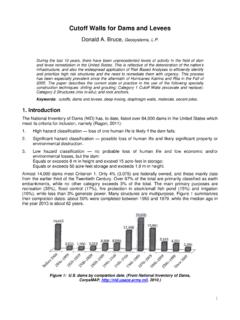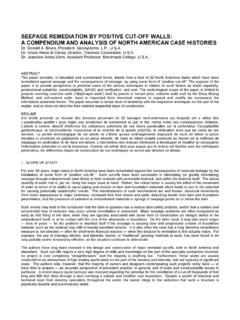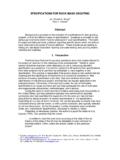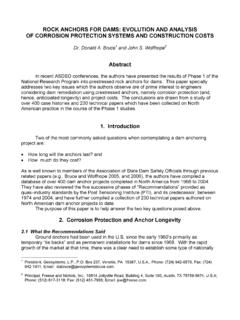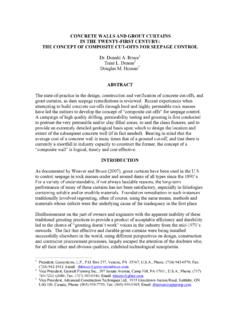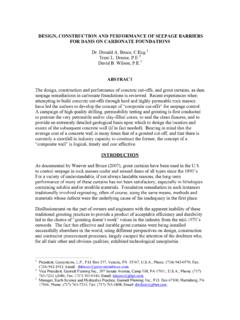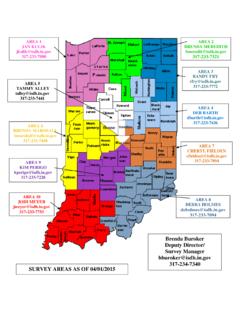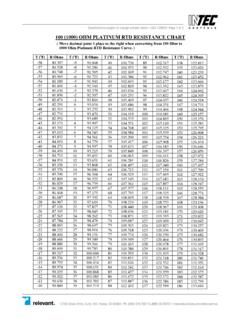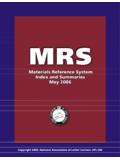Transcription of DESIGN AND CONSTRUCTION OF SEEPAGE CUT-OFF WALLS …
1 DESIGN AND CONSTRUCTION OF SEEPAGE CUT-OFF WALLS UNDER A CONCRETE DAM IN NEW ZEALAND WITH A FULL RESERVOIR Peter D Amos1, Donald A. Bruce2, Marco Lucchi3, Tom Newson4, Nick Wharmby5 Abstract Arapuni Dam is a 64m high curved concrete gravity structure across the Waikato River in New Zealand. It was completed in 1927 to form a reservoir for the 186MW hydroelectric power station. A series of foundation leakage events have occurred since water was first impounded. These were related to piping within, and erosion of, the weak clay infilling the defects within the volcanic ignimbrite rock foundation.
2 The owner of the dam required the formation of a high quality and verifiable CUT-OFF solution to be completed with the reservoir still in service. An international Alliance was formed to identify CUT-OFF options, develop them and implement the selected methodology. The paper includes the following: Commentary on different solutions evaluated. Development of the adopted solution which required the installation of 400 mm diameter overlapping piles to depths of up to 90 m. Manufacture and development of specialized plant and equipment.
3 Monitoring of the dam and foundation. CONSTRUCTION of the CUT-OFF wall and quality control. The outcome of this successfully implemented solution was the formation of a robust and verifiable CUT-OFF wall. With few precedents for this type of work and none constructed in weak rock and to 90 m depth, the Arapuni Dam SEEPAGE cutoff project significantly extends international small diameter overlapping/secant pile technology and experience. 1 Principal Engineer, DamWatch Services Limited, Level 2, 18-24 Allen Street, Box, Wellington 1549, New Zealand; Phone: +64-4 381-1300; Fax: +64-4 381-1303; Email: 2 President, Geosystems, , Box 237, Venetia, PA 15367, , Phone: (724) 942-0570, Fax: (724) 942-1911, Email: 3 Project Manager, Trevi Via Dismano, 5819, 47023 Cesena, Italy; Phone: +39 054 7 319 311; Fax: +39 054 7 317 395.
4 Email: 4 Project Manager, Mighty River Power Limited, 160 Peachgrove Road, PO Box 445, Hamilton, New Zealand; Phone: +64 7 857 0199; Fax: +64 7 857 0192; Email: 5 Engineering Manager, Brian Perry Civil, P O Box 10068, Hamilton, New Zealand, Email Introduction Arapuni Dam is a 64m high curved concrete gravity structure of crest length 94 m, on the Waikato River in the central North Island of New Zealand. It was completed in 1927 to form a reservoir for the 186MW hydroelectric power station. A series of foundation leakage events have occurred since water was first impounded.
5 These were related to piping within, and erosion of, the weak clay infilling the defects within the volcanic ignimbrite rock foundation. SEEPAGE changes have often involved sudden and significant increases, and cannot usually be related to external events, such as earthquakes. The most recent SEEPAGE incident required grouting to fill an open void within a foundation defect in December 2001 to successfully control the deteriorating condition. Details of the grouting of the void in the fracture allowing high pressure SEEPAGE are described in Amos et al (2003b).
6 SEEPAGE investigations prior to the emergency grouting established the location of the developing leak and the nature of the joint infill that was subject to piping, thereby enhancing the success of the targeted grouting operation. The concept used at Arapuni of evaluating SEEPAGE conditions in a targeted and safe manner before committing to remedial works is described in Bruce and Gillon (2003). Discussion of the overall process of monitoring, investigation and remediation for the high pressure SEEPAGE is also described in Gillon and Bruce (2002) and more detailed description of the investigation techniques employed are described in Amos et al.
7 (2003a). With the deteriorating condition arrested, the owner of the dam, Mighty River Power Ltd., required the formation of a high quality and verifiable CUT-OFF solution to be completed with the reservoir still in service. A comprehensive investigation took place to determine the extent of foundation features requiring treatment to prevent further incidents from developing. A targeted and cost effective fix involving drilling and concreting overlapping vertical piles from the dam crest through the dam and underlying rock formation to a total depth of 90m was selected to form four separate permanent cutoff WALLS at selected locations beneath the dam.
8 An international Alliance between the dam owner (assisted by their designer) and a contracting consortium was formed to identify CUT-OFF options, develop them and implement the selected methodology. CONSTRUCTION of the cutoff WALLS commenced in September 2005 and was completed in mid 2007. Operation of the reservoir has not been affected and electricity generation has continued during the project works. The Dam The dam forms the reservoir for a 186 MW hydro-electric power station, sited 1 km downstream at the end of a headrace channel that follows the left abutment.
9 Penstock intake and spillway structures are on the headrace channel. A concrete-lined diversion tunnel runs through the right abutment around the dam, with separate gate and bulkhead shafts. The dam is shown on Figures 1 and 2. Handman (1929) discusses the dam s CONSTRUCTION . Original features of the dam include concrete cutoff WALLS and a network of porous (no-fines) concrete drains at the dam/foundation interface (the underdrain ). The original cutoff WALLS extend beneath the dam to a depth of 65m below the dam crest and extend 20m and 33m into the left and right abutments respectively, for the full height of the dam as shown on Figure 3.
10 There was no grout curtain constructed during original CONSTRUCTION . The 600mm high x 600mm wide no-fines concrete porous drain network (Figure 2) is the main uplift control at the dam/foundation interface. The underdrain includes a continuous drain, known as the circumferential drain, sited parallel to, and immediately downstream of, the original cutoff wall. Radial porous drains discharge SEEPAGE water to the downstream toe, where SEEPAGE is measured at v-notch weirs. In June 1930 the reservoir was completely dewatered for a number of repairs including CONSTRUCTION of a grout curtain along the upstream heel of the dam and along the front of both abutment cutoff WALLS (Furkett, 1934).
